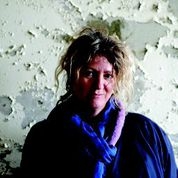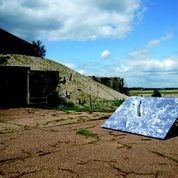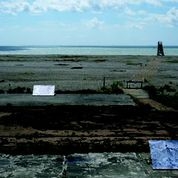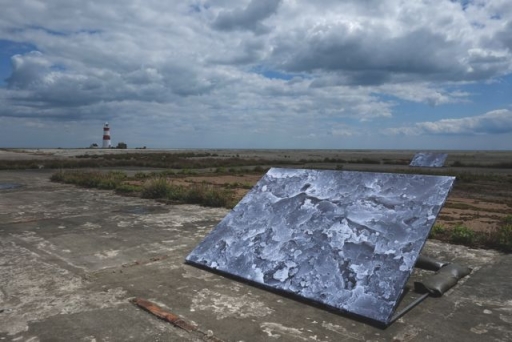Mike Swain visits Orford Ness National Trust nature reserve on the British Suffolk coast to see an exhibition of unusual photographs by installation artist Anya Gallaccio of a pebble picked from a bombing range.
The beautiful but remote shingle spit of Orford Ness is a strange place of contrasts. It is a fragile, shifting landscape which forms the best preserved shingle ridges in Europe.
And yet it is littered with derelict buildings left over from its years as a First World War bombing range and a setting for secret military experiments.
For the next two weeks it is also the place chosen for a collection of giant black and white photographs of a shattered pebble from the beach which have been created by installation artist Anya Gallaccio.

Anya Gallaccio. Photo Owain Thomas. Courtesy of Aldeburgh Music 2014.
Known for her interest in transience and transformation, she has exhibited with Damien Hirst and was a Turner prize nominee in 2003/4.
At Orford Ness she has been commissioned by Aldeburgh Music and 14-18 NOW to create new works for SNAP 2014.
Her giant photographs, placed across the strange, flat terrain, are landscapes in themselves, created from shattering a single pebble and then placing a fragment no bigger than a grain of sand under an electron microscope and magnifying it up to 24,000 times.
The images she has chosen reflect not only her interest in aerial photography but are also influenced by the idea of the traumatised landscapes of France in the First World War.
The pebble was carefully selected from a bomb crater and it showed the black and red markings of having been “traumatised” itself by a bomb.
From 1913 Orford Ness was used as a practice bombing range. Dropping bombs was an inexact science at the time. Altimeters were used to measure the height of the plane and then a system of mirrors, stopwatches and volunteer spotters calculated the speed and accuracy of falling bombs.

‘Untitled Landscape 2014.’ Installation at Orford Ness. Photo: Owain Thomas, courtesy of Aldeburgh Music and the National Trust.
Experiments carried on for decades and even today bomb disposal experts are called out to the Spit ten times a year to deal with unexploded ordnance. And yet the shingle is so fragile you are not allowed to walk on it.
As we walked along paths across the wind-blown Spit to view the photographs Anya told me: “I liked the idea that these stones had been in a kind of war.
“There are are so many ideas. For me the photographs are a kind of poetic gesture. I feel people can project on them what they want. It is quite violent. I am conscious I took a hammer to break the pebble.
“Obviously there is this whole reference to war and yes they are really beautiful objects but I am not in any way interested in celebrating or glorifying war.
Fractured landscape
“There was this idea of a fractured landscape and of the sense of aerial photographs. When I thought about the First World War I thought of the landscape of France being completely churned up.
“I think it is really important to remember. You have an idea about something and then you have to see what comes out. There is a very simple gesture to take a pebble from that beach and that beach is a bombing range.”
She had ten one hour sessions with the microscope and admits scientists thought she was “mad” as she examined the smashed fragment.
“I was using the microscope basically flying around with the microscope zooming in and out on the stone to find something which I thought as an image would look like a landscape.
“I was thinking about this idea of a torn up gashed landscape so I was trying to find lots of other images which were really organic and were really fascinating.”
Many of the giant photographs are placed near the empty, forbidding military buildings.
“The idea in placing the photographs is to look at them from above which is how they looked at the pebbles here. The photographs make more sense the further away you are and the higher up.

‘Untitled Landscape 2014′. Installation at Orford Ness. Photo: Owain Thomas. Courtesy of Aldeburgh Music and the National Trust.
“In a way the photographs are conversation pieces – a way of looking at this landscape and thinking about this landscape and the history of this place which to me is really fascinating.”
She is also interested by the transient nature of the Spit. “In terms of climate and coastal erosion this landscape is shifting and moving.
“And in some time – geological time – this won’t be a Spit any more it will be an island.
“So even though we can’t see it the shingle is really moving and the land mass is moving which is really quite dynamic and violent as well.
“Even though we might not see it, in terms of geological time it is moving quite rapidly.”
Some of Anya’s past work, such as a melting block of ice, is organic and only now exists in the memory. But she has not ruled out exhibiting the new photographs elsewhere.
“I would take them out of this landscape but in terms of making them it was really important to me that they were here. It is really important to see them in this landscape.”
Tickets to see the photographs for a 2-3 hour tour to see the photographs need to be booked through the Aldeburgh music box office in advance. www.aldeburgh.co.uk.
A few photographs are also on display outside at Snape Maltings, Saxmundham.
Aldeburgh Festival June 13-29 2014.
SNAP art at Aldeburgh Festival.
Posted by Mike Swain, deputy editor, Centenary News
